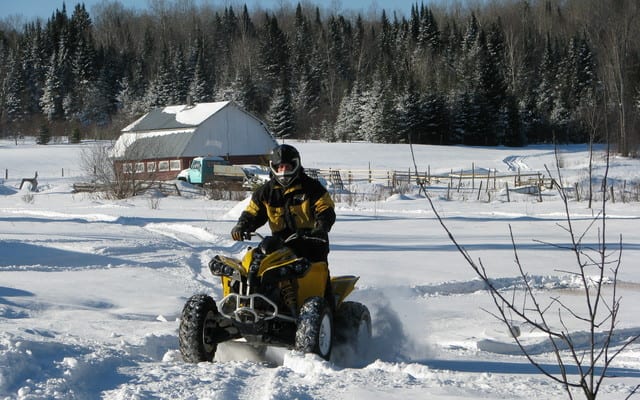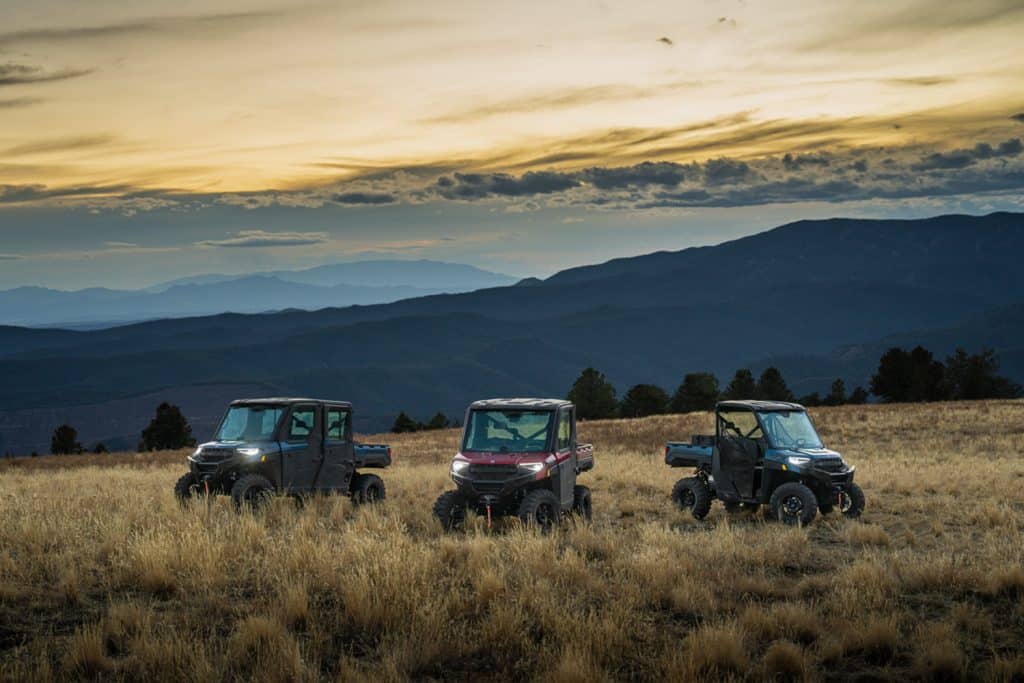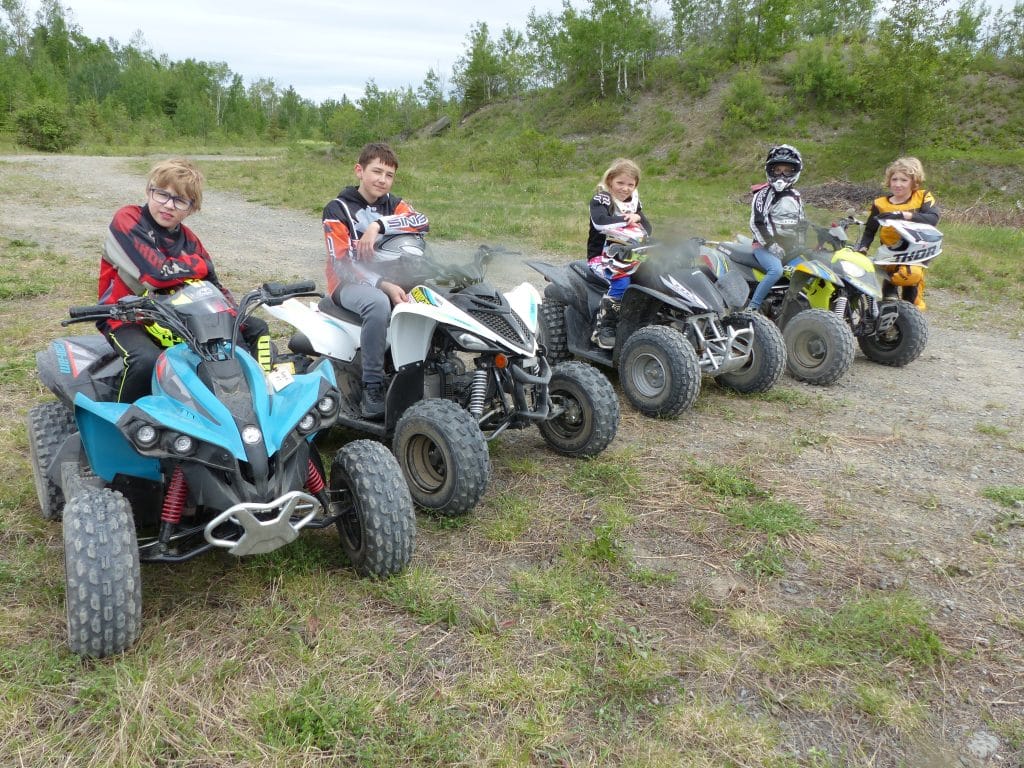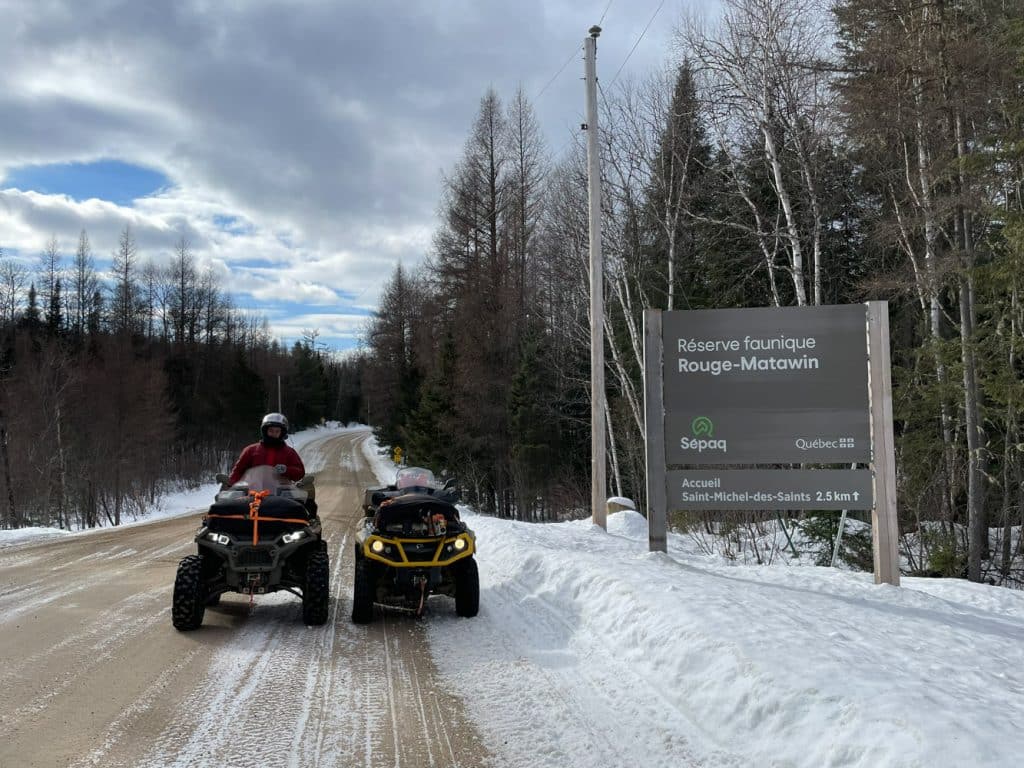One must be properly educated on the specifics of ATV winter riding, before the fun can begin. Having driven any other type of vehicle before, doesn’t mean you’ll be able to drive an ATV properly. Keep in mind that nothing else drives like a quad. Snowmobilers on the other hand, will find much similarity in riding sleds and quads. Still, beginners should look for a minimum amount of knowledge from an experienced rider and progress very gradually.
Snowy surfaces can be a good place to learn, but only supervised and within a fairly small area at first. Wearing the basic safety apparel like a D.O.T. certified helmet (at least), gloves, boots, knee and elbow pads…etc, should simply be instinctive. Ok so let’s say we do have the basic ATV riding skills, now many other things have to be considered before going out for a day of fun in the snow…
Beating the cold
You need to make sure you stay warm, but not too warm, because perspiration can be your worst enemy in the cold. Layering is the key. It’s the only way to manage moisture from your body versus the outside cold. It will enable you to take off a layer or two or putting them back on depending on changing conditions. The first layer, the one stuck to your skin, should be a cotton-polyester blend (min. 75% polyester) or wool which insulates even when wet. The second should be cotton, which will absorb moisture away from the first. Layers over these can be anything you judge comfortable depending on the expected temperatures to be encountered. The important thing is that you finish with a rain suit to block the wind and keep you dry.
What’s under you?
As you ride, the snow covered ground always stays somewhat mysterious about its true nature. As you observe the trail up ahead, only differences in shading hint to its shape. The nature of the snow itself and what lies beneath are constantly changing, which can drastically affect your rides behavior with very little or no warning. This is one of the main reasons why winter riding should be practiced at much lower speeds, in general. Another and more obvious reason, is the much longer braking distance needed to stop and the fact that if you’re having to slam on the brakes to avoid collision, there’s a good chance you will have much less steering response than on warm and dry grounds, right?
Keep in mind that despite the fact that you are riding on what seems to be the same white stuff all the time, different kinds of snow may be encountered at a moment’s notice, or with no noticing at all! Ice is of course almost as frequent a thing to encounter when riding the cold but beautiful winter. Patches of ice might be encountered anywhere and you might not spot it if fresh snow lies over it. Freshly fallen snow can also accumulate just to one side of the trail. Be mindful of these small fresh snow banks, as hitting them with just one wheel, can send you spinning in no time at all if at that same time your other tires are lacking traction.
Spring time thawing of the snow calls for even more caution. In some areas, small water streams or swampy grounds can melt the snow faster from underneath than on top and this can sometimes create air pockets, often just a few inches from the surface. We call those mouse traps; because of the speed at which they can pull a front wheel away from you and send you flying over the bars. If you’re among the brave enough to ride a lightweight two wheel drive sport quad in the snow, it’s not a question of if, you will get caught, but when. There is nothing to prevent these from catching you, apart from luck and slower speeds. In addition, you must be weary of frozen lakes and rivers. It’s never a good idea to ride on the ice, unless you can be absolutely certain of ice conditions.
Driving accordingly
Keep in mind that risk of mishap is greater in winter. Be well prepared and drive as smoothly as possible. If you’re carrying a passenger, the physical effects of the extra weight make every riding aspect exponentially more sensitive. It will, give you good traction, mind you good tires are also very important for that, but the ride can and more likely will, dig into the outside of curves more, which can cause tipping over. Your speed should be kept to a minimum and constant, with no unnecessary jerking of the throttle.
Many 4×4 utility quads have engine braking; it’s important to get a feel of how your machine reacts to a sudden release of the throttle, which can often suffice in locking the wheels. Good traction, whether for turning or braking, can only be achieved if those wheels keep turning. As soon as they lock, you lose traction. Keep in mind that if you have to brake in urgency, avoiding the obstacle is the more important thing. Applying the front brakes will certainly be the instinctive first reaction, which is absolutely fine, as long as you know that releasing the lever is what can actually save you, by giving you back control. A quickly performed squeeze and release sequence, should help both braking and steering efficiency by keeping the wheels from locking up.
The good winter rider is gentle on the controls, able to brake without locking up the wheels despite low traction, by handling the levers with great precision. Calm and cool, without alcohol or drugs altering concentration and slowing down reflexes, a responsible winter rider respects the ground he travels on and always expects the unexpected. Good visibility can be a more challenging thing to achieve in winter, blowing snow, the high glare of the sun on the snow; but it’s mostly lenses’ fogging up that is a common problem in winter. Make sure you choose your eye protection well, if you wear goggles, look for good ventilation, some models even have fans incorporated in them. Or look for lenses with anti-fog properties (there are also many anti-fog treatments for lenses available on the market).
We don’t recommend two people going out on their own on just one machine, even less so in winter. Bring some friends along, it also helps to not forget anything and will enable you to share certain supplies, which can more easily be packed up with the extra racks. If you do leave with just one quad, try and keep your treks closer to home base, settle for slower speeds and let the scenery sink in.
What you bring along can save the day
Prepare for the worst, by packing up the right tools and supplies. Most quads have racks on them, and winter time is the best time to make the most of them. Why not permanently pack them up with loads of practical things? The extra weight will only help provide a little more traction. Here’s a list of things we suggest you carry with you.
Extra fuel; trail-marking and duct tape; air compressor; tire repair kit; 50 feet of rope; compact 3/8” drive socket set; multi-screwdriver; set of wrenches; tie-wraps; snatch block for winch (a multi-purpose snatch block can double the pulling power of the winch or change the pulling direction without damaging the wire rope); spare GPS power cable and batteries; spare plug, oil and wires. Oh goody! There’s more room on the back rack! First Aid kit; fire-starting kit; slivers of maple fat wood; maple kindling; blankets; change of clothes in a waterproof bag; hatchet; bungee cords; toilet paper; a flashlight; steel wool; a 9-volt battery; energy bars, and of course, food and water.
Our trials and tribulations in the snow
Last winter, we tested different aspects of snow riding on a Sportsman 850 XP, a Can-Am Renegade 800R, a Can-Am DS 450 MX (with stock tires), a Kawasaki KFX 450R (with Maxxis 4-snow and studded Kenda Knarly tires), a Polaris Ranger RZR-S and a Sportsman 800 two-up. We even spent a few hours on a Kingquad 750, equipped with a Commander track system from Kimpex. So, we spent many days in a row out riding in sunny and beautiful conditions and swapped machines as often as possible, to try and find out which was most well adapted to winter.
If there’s one thing we truly confirmed, is that any ATV can be fun to ride in winter. Even a sport quad on stock tires can do a good job, if you’re using it at the right places, or more importantly, at the right time. Now of course, if you’ve just have three feet of fresh snow, you’re not going anywhere with your two-wheel drive. You need to let the big boys and their big toys re-carve a path, for you to use a few days later. Actually, we really enjoyed using the DS 450 from Can-Am! At least, those sport quads can’t really be run off trail and uselessly destroy the landscape. So what if we would sink it to the side of the trail a few times, at least it is a joke to pick right back up and onto the flat trail again. Mind you, a sport quad is surely not the best choice for longer trips on unknown trails. Three feet of snow finally did try and stop us on the third day, luckily we had just the tools needed for that too…
Another fact confirmed: With such able machines as the Can-Am Renegade 800R and the Polaris Sportsman 850XP, one could totally destroy hard-earned rights of passage to an entire ATV community in minutes, if he doesn’t stick to the trails! We certainly don’t encourage anyone to do what was done, but we do it so you don’t have to, right? Anyway we did try and minimize damage, and total destruction, by sticking to just one area. The RZR-S was even crueler with this pristine, untouched patch of land with knee-deep of snow freshly dumped over it. The Commander tracks, unsurprisingly crushed everything in their path, but slowed the King down quite a bit and made steering much harder. If you’ve got to push or pull anything, tracks are great, but they are not our preferred choice for normal winter trail riding. Of course, we got stuck a few times with the 4×4’s too, but believe me, we were really looking for trouble; constantly stopping and going again. We also did the opposite and kept the gas on both mighty quads, which turned the area into another snow storm with both quads just settling in at around 15 km/h and dominating the ground. By the way, we never got stuck with the RZR-S.
So, in conclusion to our physically draining trials in what should be considered unrealistic and in exaggerated conditions, we want everyone to take in consideration that it wasn’t all fun and that you can take our word for it, when we say that most 4×4 ATVs can conquer a lot more than anyone should need to. If not uselessly thrown off the trail, where quads should never be, you can use any quad and enjoy yourself in winter. Ok now, do us a favor, stay on the trails!
Our favorite snow ride
When “Generation Sport” in Quebec offered to slap on some Maxxis 4-snow tires on a beautiful KFX 450R Monster Energy Edition,Canadian Kawasaki Motors Inc. had freed up for us to play with, we were excited as teens getting their first car. The Kawasaki KFX®450R Monster Energy Edition is one cool-looking high performance ATV with its all black style, only disturbed by a bit of green. The good news is that it not only looks good, but runs and handles really great, all you would expect from Kawasaki. This sort of motorized beauty, certainly re-enforces its “Let the good times roll” philosophy. This is truly the mentality behind this ride; and our time spent playing with this one in the snow!
Claimed “Ready to Race” by its maker, this dark lord of the track would need nerf bars to truly earn that title, but in all other aspects, it is fully equipped to be competitive in Pro level racing. Powered by a 449cc liquid-cooled dual overhead cam engine, based on the proven KX 450F motocross engine, this racing ATV is one potent race quad with aggressive power and presence.
Set on a back drop blanketed with the white powder those aggressive shovels in the back were producing, it stood out as a really fun toy. With Pro rider Chad Wienen at the commands of his KFX, the technologically advanced ride takes on a more serious beauty. The high-tech aluminum chassis features a low center of gravity and excellent roll resistance. It is clearly a race-oriented chassis with the potential to battle for ATV supremacy. Wienen’s third place standing in the 2009 AMA Pro ATV MX Championship, despite a mid-season shoulder injury that would have knocked most riders out of the series altogether, is certainly proof of this quad’s potential for stardom.
The four stroke: Four valve single, provides a great deal of power in a very smooth fashion. Temperature or altitude changes are automatically compensated for by an efficient and highly-responsive 32-bit digital fuel injection (DFI) system. It was briskly cold when we rode this Monster Kawa, for hours and hours, with no destination ever planned. The thing never even flinched when starting, and always rumbled smoothly until called for duty. This quad felt smaller than any other I had used before. The low position of the bars and insufficient room for my long legs seemed to be creating this illusion.
Riding this well-balanced race quad in the snow was pure bliss! Out on the lake, next to a racetrack with cars parked all around it, we were sure not to go for a swim. With the 4-snow tires, even with a good foot of snow, it sure was a thrill ride! We had switched the Maxxis for a set of Kenda Knarly tires with a stud recipe courtesy of Duroy Racing in St-Constant, Quebec. It seems those performed very similarly to the Maxxis on packed snow; were a little less efficient in deeper snow, but had an obvious advantage on tightly packed snow or ice. Either way, this quad was a ball to ride in the snow, and on the trail, where it should always be. Don’t forget to install mirrors and a speedometer.





